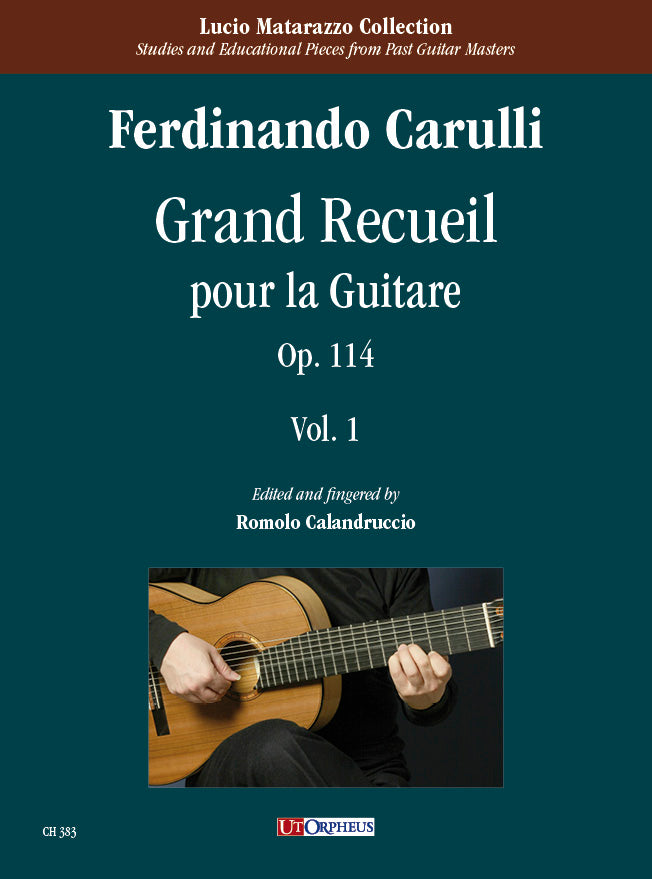Carulli: Grand Recueil, Op. 114 - Volume 1 (First and Second Part)
In stock and typically ships within 1 business day.
- Composer: Ferdinando Carulli (1770-1841)
- Editor: Romolo Calandruccio
- Instrumentation: Guitar
- Work: Grand recueil, Op. 114
- ISMN:
- Size: 9.1 x 12.2 inches
- Pages: 72
Description
Op. 114 is certainly one of Carulli's most important didactic works, so much so that the author himself made a point of writing in the second edition of his famous Method, Op. 27 (1819): "The student, when moving on to the second part, must continue to practise on the easy pieces which are to be found in opus nos. 50, 15, 35, 36, 93, 7 and above all in opus 114".
He maintained this indication also in later editions of the Method itself, unlike what he did with other collections of studies which were no longer recommended. The purpose of, Op. 114, in particular of the preludes, is clearly explained by the author himself in the preface of, Op. 265: "I have already offered preludes in my opus nos. 71 and 114 to people, but they serve to study and learn to play all sorts of difficult passages, to practise modulating, and learn to improvise on the guitar".
Carulli seems to want to provide his students with a large "handbook" of formulas typical of his musical writing and he does so by making use of the keys which, in his opinion, are most congenial to the guitar. in his Method he points out: "Each instrument has its favorite keys: the guitar can be played in all keys, but the best ones are: In in A Major and Minor, D Major and Minor, E Major and Minor, C, G, F. The others are difficult; […]". However, some of the "difficult" ones are included but only in the fourth part. of course, the easiness of a key essentially depends on the possibility of extensive use of the open strings, especially in the low notes, ensuring the accompaniment on the main degrees.
Publishers use a lot of words to describe what they sell, and we know it can be confusing. We've tried to be as clear as possible to make sure you get exactly what you are looking for. Below are descriptions of the terms that we use to describe the various formats that music often comes in.
Choral Score
A score for vocalists that only contains the vocal lines. The instrumental parts are not there for reference. Generally, cheaper than a vocal score and requires multiple copies for purchase.
Facsimile
Reproductions of the original hand-written scores from the composer.
Full Score
For ensemble music, this indicates that the edition contains all parts on a single system (there are not separate parts for each player). In larger ensembles, this is for the conductor.
Hardcover
Hardbound. Generally either linen-covered or half-leather.
Orchestral Parts
Similar to a wind set, this is a collection of parts. In the case of strings, the numbers listed are the number of copies included, though generally these are available individually (often with minimum quantities required).
Paperback
When publishers offer multiple bindings (e.g. hardcover) or study scores, this is the "standard" version. If you're planning to play the music, this is probably what you want.
Performance / Playing Score
A score of the music containing all parts on one system, intended for players to share. There are not separate parts for each player.
Set of Parts
For ensemble music, this indicates that there are separate individual parts for each player.
Solo Part with Piano Reduction
For solo pieces with orchestra, this is a version that contains a piano reduction of the orchestra parts. For piano pieces, two copies are typically needed for performance.
Study Score
A small (think choral size) copy of the complete score meant for studying, and not playing. They make great add-ons when learning concertos and small chamber works.
Vocal Score
A score prepared for vocalists that includes the piano/organ part or a reduction of the instrumental parts.
Wind Set
For orchestral music, this is a collection of wind and percussion parts. The specific quantities of each instrument are notated.
With Audio
In addition to the printed music, the edition contains recordings of the pieces. This may be an included CD, or access to files on the internet.
With / Without Fingering (Markings)
Some publishers prepare two copies - a pure Urtext edition that includes no fingering (or bowing) suggestions and a lightly edited version that includes a minimal number of editorial markings.


